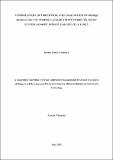| dc.description.abstract | Active plant molecules like polyphenols have been repositioned increasingly utilized for
managing breast cancer traditionally. However, polyphenols possess poor lipid miscibility, that
results in poor bioavailability and decreased efficacy. ‘Phytosome’ is a plant based nanocarrier
that improves the bioavailability of the polyphenols. The purpose of this study was to improve
the bioavailability of Moringa oleifera Lam leaf polyphenols (Mopp) through encapsulation
with phytosomes to enhance their activity on 4T1 cancer cell lines. The Mopp phytosomes
were extracted by microwave-assisted extraction. Moringa oleifera polyphenols-loaded
phytosomes (MoP) were prepared by the nanoprecipitation method and characterized by a
dynamic light scattering technique. The ultraviolet-visible spectroscopy determined the
percentage entrapment efficiency (EE%). Fourier-transform infrared (FTIR) spectroscopy
assessed MoP formation. The dialysis membrane technique investigated in vitro drug release
while storage stability test analysis identified MoP stability. The in vitro cytotoxic activity of
MoP on E6 Vero cell lines and anti-proliferative activity on 4T1 cancer cell lines were
investigated by MTT (3-[4,5-dimethylthiazol-2-yl]-2,5 diphenyl tetrazolium bromide) assay,
while female Swiss albino mice were used to assess acute toxicity. Results showed that MoP
average particle size was 296±0.29 nm, a zeta-potential of -40.1±1.19 mV, and polydispersity
index of 0.106±0.002. The Mopp total phenolic content was 50.81±0.02 mg GAE/g, EE% was
90.32±0.11%, while FTIR spectra demonstrated successful formation of phytosomes. The drug
release profiles demonstrated biphasic behavior of immediate burst release and subsequent
prolonged sustained release. The in vitro cytotoxicity assays indicated that the MoP had low
cytotoxic effect of 98.84±0.53 μg/mL on E6 Vero cells; while doxorubicin had
68.35±3.51while Mopp was 212.9±1.30 μg/mL. Moreover, MoP exhibited the highest
antiproliferative effect on 4T1 cancer cells with an inhibitory concentration of 7.73±2.87
μg/mL and selectivity index >3. The results indicated a significant difference (p≤ 0.001) in
MoP when compared to Mopp and doxorubicin. In vivo investigation confirmed the safety of
MoP on mice at a dose below 2000 mg/kg. The present findings suggest that the MoP can serve
as an effective and promising formulation for breast cancer drug delivery in cancer therapy. | en_US |

